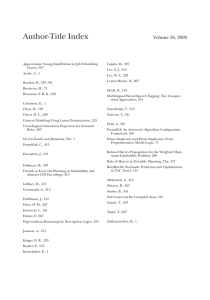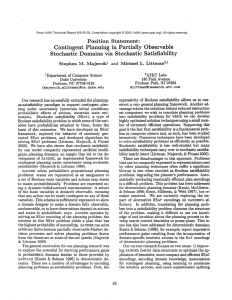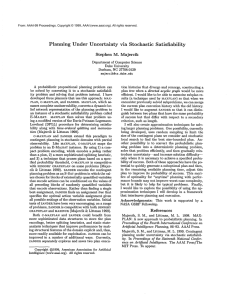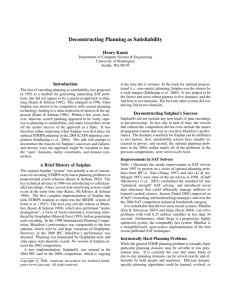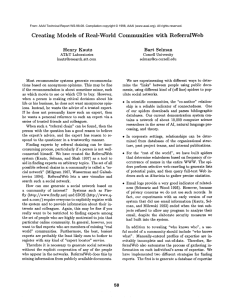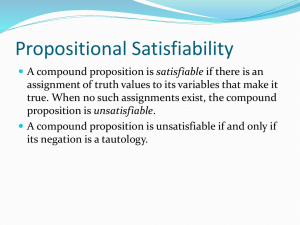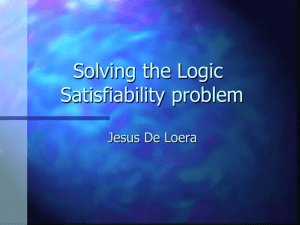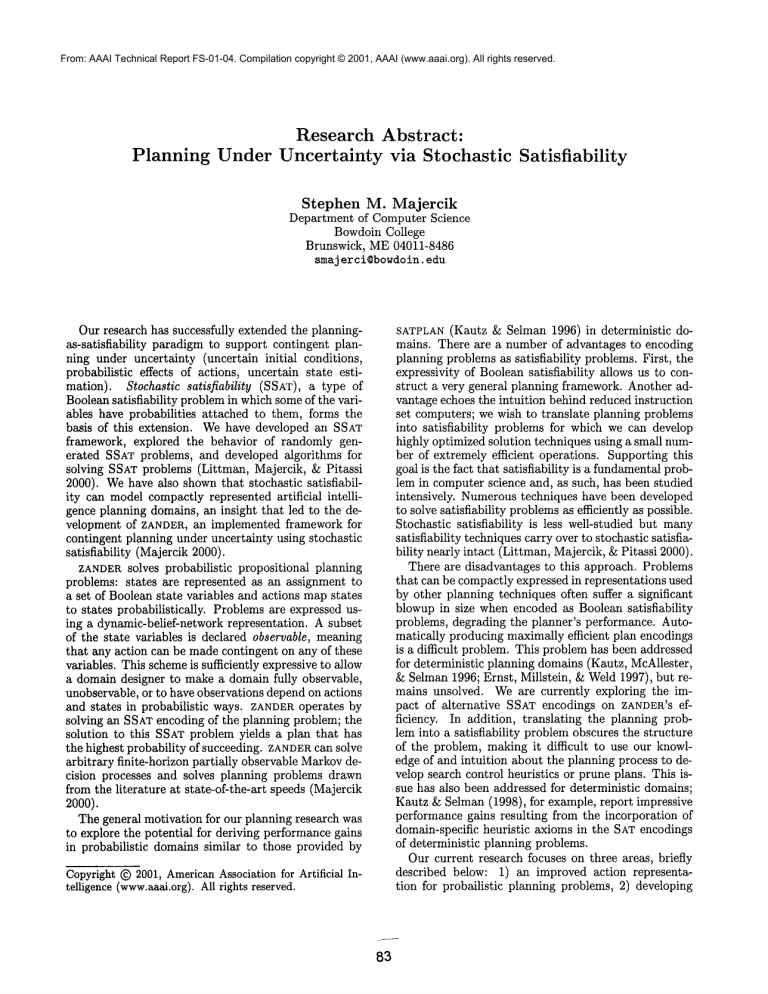
From: AAAI Technical Report FS-01-04. Compilation copyright © 2001, AAAI (www.aaai.org). All rights reserved.
Research Abstract:
Planning Under Uncertainty via Stochastic
Stephen
Satisfiability
M. Majercik
Department of Computer Science
Bowdoin College
Brunswick, ME04011-8486
smajerci©bowdoin,
edu
Our research has successfully extended the planningas-satisfiability
paradigm to support contingent planning under uncertainty (uncertain initial conditions,
probabilistic effects of actions, uncertain state estimation). Stochastic satisfiability
(SSAT), ty pe of
Booleansatisfiability problemin which someof the variables have probabilities attached to them, forms the
basis of this extension. Wehave developed an SSAT
framework, explored the behavior of randomly generated SSATproblems, and developed algorithms for
solving SSATproblems (Littman, Majercik, & Pitassi
2000). Wehave also shown that stochastic satisfiability can model compactly represented artificial intelligence planning domains, an insight that led to the development of ZANDER, an implemented framework for
contingent planning under uncertainty using stochastic
satisfiability (Majercik 2000).
ZANDERsolves probabilistic
propositional planning
problems: states are represented as an assignment to
a set of Boolean state variables and actions map states
to states probabilistically. Problems are expressed using a dynamic-belief-network representation. A subset
of the state variables is declared observable, meaning
that any action can be made contingent on any of these
variables. This schemeis sufficiently expressive to allow
a domain designer to make a domain fully observable,
unobservable, or to have observations depend on actions
and states in probabilistic ways. ZANDER
operates by
solving an SSAT encoding of the planning problem; the
solution to this SSATproblem yields a plan that has
the highest probability of succeeding. ZANDERcan solve
arbitrary finite-horizon partially observable Markovdecision processes and solves planning problems drawn
from the literature at state-of-the-art speeds (Majercik
2000).
The general motivation for our planning research was
to explore the potential for deriving performance gains
in probabilistic domains similar to those provided by
Copyright © 2001, AmericanAssociation for Artificial Intelligence (www.aaai.org).All rights reserved.
SATPLAN
(Kautz & Selman 1996) in deterministic domains. There are a number of advantages to encoding
planning problems as satisfiability problems. First, the
expressivity of Boolean satisfiability allows us to construct a very general planning framework. Another advantage echoes the intuition behind reduced instruction
set computers; we wish to translate planning problems
into satisfiability
problems for which we can develop
highly optimized solution techniques using a small number of extremely efficient operations. Supporting this
goal is the fact that satisfiability is a fundamentalproblem in computer science and, as such, has been studied
intensively. Numeroustechniques have been developed
to solve satisfiability problemsas efficiently as possible.
Stochastic satisfiability
is less well-studied but many
satisfiability techniques carry over to stochastic satisfiability nearly intact (Littman, Majercik, &Pitassi 2000).
There are disadvantages to this approach. Problems
that can be compactly expressed in representations used
by other planning techniques often suffer a significant
blowup in size when encoded as Boolean satisfiability
problems, degrading the planner’s performance. Automatically producing maximally efficient plan encodings
is a difficult problem. This problem has been addressed
for deterministic planning domains (Kautz, McAllester,
& Selman 1996; Ernst, Millstein, & Weld 1997), but remains unsolved. We are currently exploring the impact of alternative
SSAT encodings on ZANDER’S efficiency.
In addition, translating the planning problem into a satisfiability problem obscures the structure
of the problem, making it difficult to use our knowledge of and intuition about the planning process to develop search control heuristics or prune plans. This issue has also been addressed for deterministic domains;
Kautz & Selman (1998), for example, report impressive
performance gains resulting from the incorporation of
domain-specific heuristic axioms in the SATencodings
of deterministic planning problems.
Our current research focuses on three areas, briefly
described below: 1) an improved action representation for probailistic planning problems, 2) developing
and assessing alternate SSATencodings of probabilistic
planning problems, and 3) developing an approximation
technique for solving SSAw-encodedplanning problems
that will allow us to scale up to larger domains.
First, we are developing 7~AT~, a high-level action language that is an extension of the action language fl, T~ developed by Giunchiglia, Kartha, and Lifschitz (Giunchiglia, Kartha, & Lifschitz 1997). ~oAT~
allows the user to express probabilistic planning problems in a natural, flexible, and compactformat. In particular, 7~.A7~gives the user the opportunity (but does
not require them) to easily express domain invariants
and action preconditions--information that can greatly
decrease the time required to find a solution. The 7)AT~
representation is then automatically converted to an
SSAT representation for solution by ZANDER.
Second, we are developing and assessing alternate
SSATencodings of planning problems. Our current encodings are similar to the linear encodings with classical frame axioms described by Kautz, McAllester, and
Selman (Kautz, McAllester, & Selman 1996) for deterministic planning problems. Two other possibilities are analogous to linear encodings with explanatory
frame axioms, and GRAPHPLAN-style
encodings (Kautz,
McAUester,& Selman 1996). A further interesting possibility is to construct hybrid encodings. Although it
is not always true that more constraints (clauses)
better, adding clauses that make implicit information
explicit (in the manner of caching lemmas in a theorem prover) or restate information in a different form
can frequently guide the solver to a solution more efficiently. In one domain, this approach reduced the solution time from 9300 CPUseconds (linear encoding with
classical frame axioms) to less than a second (linear encoding with explanatory frame axioms augmented with
GRAPHPLAN-style
axioms).
Finally, we are developing an approximation technique for solving SSATencodings of planning problems.
The uncertainty in a probabilistic planning problem is
encoded in chance variables. A chance variable is a
Boolean variable that has an independent probability
associated with it indicating the probability that that
variable will be True. In our approximation technique
the possible assignments to these chance variables are
enumerated in decreasing order of probability (consider
what is most likely to happen first). For each assignment, the solver finds all the settings of the action variables that are consistent with this assignment. At any
point, the the enumeration can be stopped and an approximation of the optimal plan constructed. Of course,
if all chance variable assignments are considered, the
optimal plan is discovered. Tests so far, however, indicate that frequently only a relatively small fraction
of the assignments needs to be considered in order to
construct an optimal or near-optimal plan.
Proceedings of the Fifteenth International Joint Conference on Artificial Intelligence, 1169-1176.
Giunchiglia, E.; Kartha, G. N.; and Lifschitz, V.
1997. Representing action: Indeterminacy and ramifications. Artificial Intelligence 95(2):409-438.
Kautz, H., and Selman, B. 1996. Pushing the envelope:
Planning, propositional logic, and stochastic search. In
Proceedings of the Thirteenth National Conference on
Artificial Intelligence,
1194-1201. AAAIPress/The
MIT Press.
Kautz, H., and Selman, B. 1998. The role of domainspecific knowledge in the planning as satisfiability
framework. In Proceedings of the Fourth International
Conference on Artificial Intelligence Planning, 181189. AAAIPress.
Kautz, H.; McAllester, D.; and Selman, B. 1996. Encoding plans in propositional logic. In Proceedings
of the Fifth International Conference on Principles
of Knowledge Representation and Reasoning (KR-96),
374-384.
Littman, M. L.; Majercik, S. M.; and Pitassi, T. 2000.
Stochastic Boolean satisfiability.
Journal of Automated Reasoning. In press.
Majercik, S. M. 2000. Planning Under Uncertainty
via Stochastic Satisfiability.
Ph.D. Dissertation, Department of Computer Science, Duke University.
References
Ernst, M. D.; Millstein, T. D.; and Weld, D. S. 1997.
Automatic SAT-compilation of planning problems. In
84

